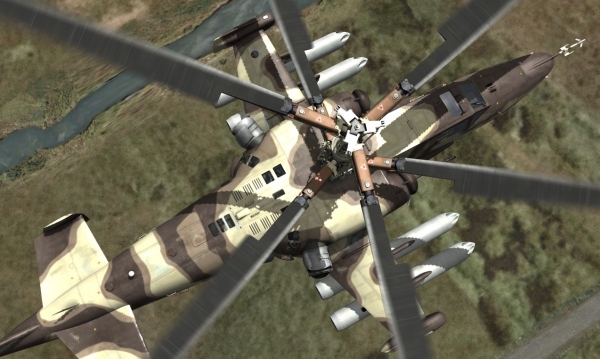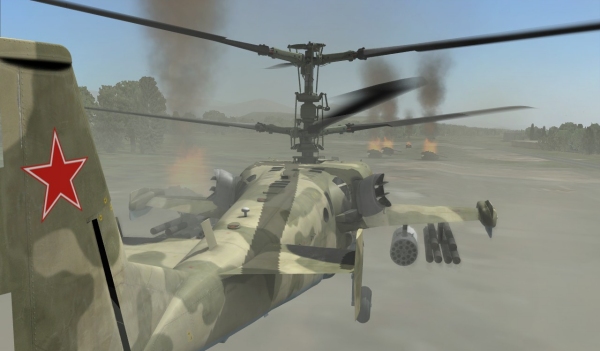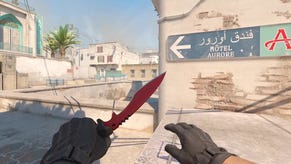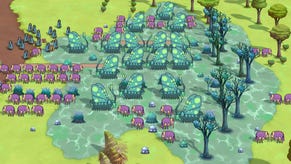Interview: Matt Wagner On Black Shark
Most of the people that made high-fidelity flight sims in the Nineties are now making low-fidelity games about snowboarding, car theft, and pony care. Moscow-based Eagle Dynamics is one of very few studios that has survived and kept the faith. They've just released Black Shark, a helo hymn that doesn't so much simulate the Ka-50 ground attack chopper as steal its soul. Sadly, I can't say too much about the sim at present (because I'm scrutinising it for the lovely PC Gamer UK) but I did catch-up with project lead Matt Wagner recently and ply him with questions.
RPS: Can you say something about your route into the industry? I know you cut your teeth working on some of the great EA/Jane's sims. What were the most useful things you drew from that period?
Matt: Prior to joining the Baltimore studio of EA/Jane’s Combat Simulations (F-15 and F/A-18), I was a military analyst at CIA. The combination of military system ground-truth knowledge and being a long-time flight simulation junkie proved useful when joining the Baltimore team as a game designer. However, even prior to that, I did a lot of outside testing, consulting, mission design, and making an effort to understand the environment of developing a PC simulation. Probably the biggest thing I came away with was the knowledge of how all the design, programming and art assets come together and the constraints imposed on development that most folks outside looking in do not appreciate.
RPS: What was it like to have to abandon a project like A-10 Warthog [an infamous cancelled EA/Jane's sim]?
Matt: That was being done at the Austin Studio (home of the Longbow series), and to this day I am still a bit unclear why that project was let go. Given that we at TFC/Eagle Dynamics are now working on DCS: A-10C Warthog, I’m thrilled that simmers out there will finally get a very detailed and authentic A-10 simulation.
RPS: Black Shark at maximum realism is an extraordinarily complex creature. To the non-simmer, the idea of clicking twenty different switches just to ready a virtual helo for flight, is going to seem insane. Are simmers a breed apart?
Matt: Flight simmers are indeed a very interesting breed of computer game consumer - particularly the online flight simulation community! For the “hard core” simmer, the closer the game can get to replicating reality the better. Be this 20 steps to start the aircraft or a flight model that accounts for every nuance of flight, it is demanded (I do not use that word lightly) by our core-customer. If not there, we will certainly hear about it! What is interesting is that we often hear desires for other elements like dynamic campaigns and radio communications that are very far from reality. It’s a difficult balance of trying to please the majority of our core consumer base, while at the same time making a successful product for the much larger casual gamer. With DCS: Black Shark, we spent a lot of time and effort trying to include options to appeal to both types of gamers. While you can never make everyone happy, we hope we’ve at least made the users that have grown up playing flight simulations feel happy that they have a new, quality game to continue the genre.
RPS: There's no dynamic campaign system in Black Shark, but I've heard talk of a new trigger system. How does that work and what does it bring to the average sortie?
Matt: Ah, the old dynamic campaign topic. Going back to the previous question about accuracy, at this time we do not feel a dynamic campaign works well for an attack helicopter game. For a proper battlefield environment, we require ground forces to be actively engaging each other and on the move. Additionally, we need to be able to create detailed and realistic AI Forward Air Controller interactions with the player and we want to be able to script realistic battle-flow. This simply has not been the case with previous helicopter simulations with dynamic campaigns, nor are we at the point we can create such a dynamic campaign system… yet. In the meantime, we’ve focused our efforts on creating a Mission Editor system that allows the mission designer to create triggers that allow cause and effect actions on the battlefield that give it a more live, and realistic feel. With this system, we’ve been able to create the realistic battlefield that we feel has been lacking in dynamically generated missions. As DCS evolves, new triggers will be added as well as all new Mission Editor functions. In multiplayer mode, realistic Forward Air Controller interactions with the pilots is achieved if one player takes the role of the Forward Air Controller.
RPS: What kind of help did you receive from Kamov during the development of Black Shark?
Matt: In order to provide the most realistic experience of flying the Ka-50, Kamov has supplied us with a host of information not available to the general public. Once we had beta versions of the software available for testing, Kamov reviewed the software for accuracy (systems and flight dynamics) and helped us revise the simulation for greater realism.
RPS: Did feedback from real Ka-50 pilots help shape any part of the sim?
Matt: Most certainly. Given the unique flight characteristics of the Ka-50, it was important that we have the real operators of this aircraft fly our simulation and provide feedback as to what was right and wrong. Their participation in the testing of the simulation contributed greatly to the level of detail and accuracy of the flight dynamics. In addition, on the beta tester team we have had a maintenance engineer who works on Kamov civilian helicopters, and many of the systems are similar to those in the Ka-50. Since the release of the project, we’ve been very happy to see the very positive responses from actual helicopter pilots about how authentic the feeling of helicopter flight is in DCS: Black Shark.
RPS: How do you think a skilled Black Shark user would get on in the real thing?
Matt: In regards to starting up the aircraft and working the various systems, I think an owner of DCS: Black Shark would feel right at home. With some practice too, flying the aircraft without breaking your neck would be much accelerated after experience with our simulation, provided that the player had some experience in flying a real helicopter. Nothing can replace the “seat of your pants” feeling of flying the real aircraft, and that can only be accomplished with the real thing.
RPS: Would ED rather work on sims for the military or the public? I get the feeling defence departments pay more and complain less.
Matt: We want to work on both! The developments are very much complementary. We have a development engine, which for want of a better term we call TFCSE (The Fighter Collection Simulation Engine). This engine is under continuous development and enhancement. Therefore the military gains an advantage of using technology that is state of the art, and the public get an entertainment title that has improved fidelity from our military experience (obviously limited to those are areas that are not classified!). We therefore can amortise our development costs across two markets, to the benefit of all. Military contracts are not a license to print money, as often they are required to be done on a "cost plus" basis, and I can assure you that they are very demanding as the simulation has to be perfect so as not to introduce "negative training". In addition, gaining/winning military contracts is highly unpredictable, whereas for entertainment titles, we can plan a business over several years.
RPS: ED is famous for fashioning Russian aircraft. How do you decide what aircraft to 'do' next, and how important do you think that choice is to sales?
Matt: There are two primary factors that determine what will come next in the DCS series. The first, as mentioned above, is if the entertainment project can be based on the existing work of one of our military contract projects. This can save an immense amount of time in game development, but it is also subject to sensitivity-review by the military client and the time to get the needed permissions can be excessive. The next determination item depends on the availability of documentation about the aircraft at a 100% open-source level. For example, there can be no arms export act restrictions on the source documentation. This data not only needs to include basic instrumentation and operations data, but also detailed data on the operation of sensor and weapon systems. This can be very difficult to come by and another reason why branching our military projects into game projects is all the more important. We often get requests from online gamers for various aircraft, but the vast majority of them are not feasible due to the lack of information needed to do them properly at a DCS-level of accuracy (very high!). Now, assuming we had two aircraft with equal levels of documentation and base-work completed, then a primary factor in the choice would come down to what we think our customers would most like to fly.
RPS: I remember Carl Norman talking vaguely of a combination armour-air combat sim in pre-LOMAC days. Is there any chance ED will ever travel that road?
Matt: Actually, the whole concept of the digital battlefield goes back much further. Microprose, Spectrum Holobyte, and then later SSI have all had aspirations of creating a unified battlefield environment that aircraft would be added to with add-ons/modules. What is old is new again it seems, and we see other companies trying to go down this route as well. What we are doing with Digital Combat Simulator will at least initially just focus on aircraft system (fixed wing and rotary wing). However, that is not to say that further down the road that we may not add land and sea elements that the player can control (either first person or third person in an RTS manner).















